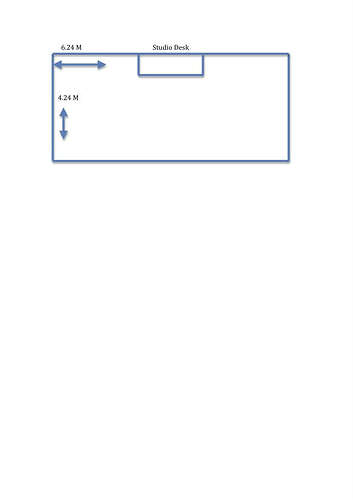Hey I have a question in regards to how I might treat my studio.
Like most, my studio is combined with my bedroom and I’m looking to improve my setup as best possible.
My room is a rectangle approx 6.24 metres by 4.24 metres with tile flooring. At the moment the only things that act as sound absorbers are my bed, couches, random bits of furniture and two large carpets. I also use two KRK 6 Inch Monitors.
Below is sorta what it looks like.
First I’m wondering. Should my studio desk be in the middle of the long or short walls??? My friend said it should be in the middle of the short wall as atm there is a shorter delay for the sound to bounce back from the wall behind me. So pretty much I get some real annoying reverb whenever I play a sample.
Second, being such a large room and myself being a uni student. It is impractical to try and sound proof all the walls so where would the most important areas be? I was thinking directly behind my monitors and the respective corners to the left and right.
If anyone could offer any advice it’d be greatly appreciated!
RT.
I’m pretty sure your desk should be flush with the short wall, and the first thing you should try to get are bass traps.
Four floor-to-ceiling bass traps will solve about 75% of the problems in a room, and from there you can get a few absorbers to place on reflection points that exist between your monitors and your ears. So, you would have treatment directly behind your monitors on the wall your desk is on, and ear-level treatment on the side walls where reflections would coming from in that area. Lastly, a cloud right above you would be nice as well.
You’re lucky to have a rectangular room! That is desirable for acoustics. Many usually have square-shaped rooms, which are a pain in the rear to “correct.”
J
Fantastic, exactly what I needed to hear.
That sounds about right with what else I have been told.
Thanks dude! 
Check this:
[url=http://audio.tutsplus.com/tutorials/recording/a-basic-guide-to-acoustic-treatment/]
Beginner's Guide to Acoustic Treatment
 http://postimage.org/image/2yq2fsov8/
http://postimage.org/image/2yq2fsov8/
1.Bass traps in the corners of your room , may also treat between ceeling & walls
(to treat low frequencies)
2,3 absorption tiles/acoustic panels (early reflection)
4.Diffusers (back,ceiling) can be placed above hard surface such as computer monitors/workstation.
Put some foam under the studio monitors to isulate them. Foam from auralex or other.
Studio monitors should be at a ear level, speakers equal distance from each wall.
Studio monitors position in a triangle to the head.
I hope that helps.
Helps a lot. Thanks guys I know pretty much want I need. Very informative.
For anyone else looking for similar information and can’t be bothered reading this video sums it all up nicely as well.
The Importance of Placement of Auralex® Acoustical Products - YouTube
Werd!
RT
Get REW (room EQ Wizard)
Get an acoustic measurement mic
Buy Rockwool
Build Frames
Build bass traps
Use a mirror to figure out the first reflection points in your room, place appropriate absorption/diffusion there.
Absorption in all corners floor to ceiling will help with “some” bass but will mostly deal with HF`s.
Make sure your monitors are calibrated and positioned as part of an equlateral triangle with your listening position which should be .38 the length of your room (38%) from the front wall (or the back).
A cloud and back wall absorption/diffusion is required, try to leave “at least” the same amount of an air gap behind your absorption (this will vastly improve the amount of absorption) as the thickness of said absorption.
Positioning is king, mess around with listening position and monitor placement (try 37%, 39% etc - move monitors acordingly) when doing measurements.
Bass is by far the most difficult to deal with, especially below 300Hz.
You will also be experiencing flutter with the tiled floor, get some big rugs down on the floor, especially where you dont have cloud.
I am about to release some free videos teaching all this, i will et you when they are done.
Mark


